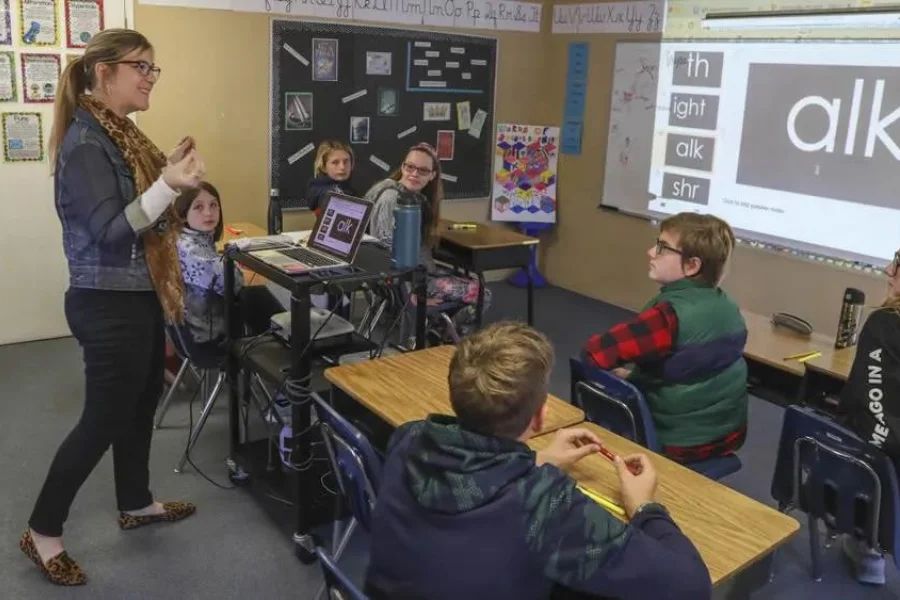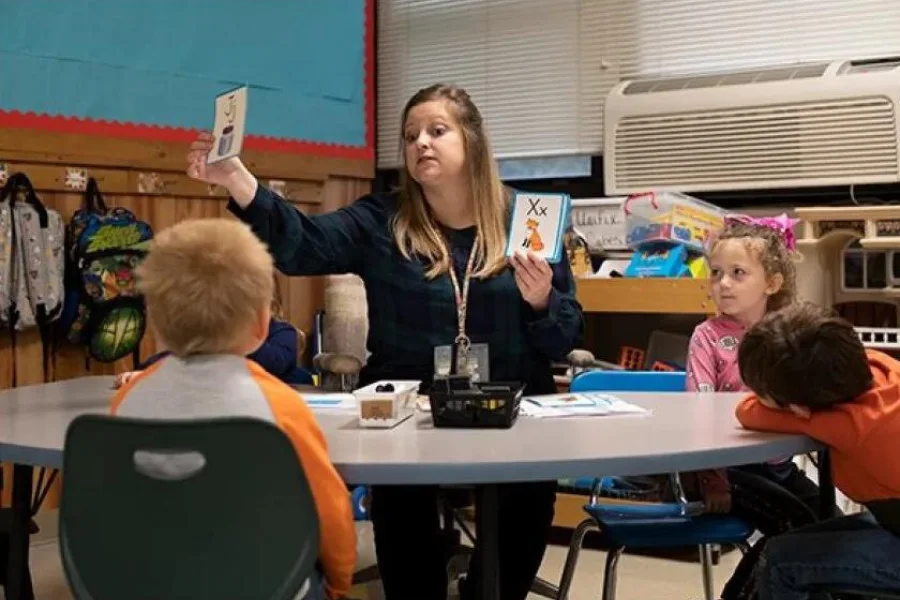Teaching CVC Words

Source: landmark
Teaching CVC Words
Teaching CVC Words is an important step in initial literacy teaching, providing an upfront method for blending sounds into meaningful units. The journey of mastering reading and writing for young children begins with these simple, yet crucial building blocks.
In this blog, we will explore creative approaches and engaging activities for Teaching CVC words through the Phonics Teaching Course, ensuring that both educators and parents can support children in this crucial phase of language expansion. Teaching CVC Words by incorporating innovative Teaching CVC Words Activities lays the groundwork for developing more intricate reading skills, and we are here to guide you through every step of this exciting learning methodology.
Table of Content

Source: brightspotcdn
What should I Teach before CVC?
CVC Words form fundamental elements of early literacy. Yet, educators and parents must introduce several foundational concepts to children before diving into Teaching CVC Words, to ensure smooth and efficacious learning.
The following will assist in What Should You Teach before CVC:
Phonemic Awareness: The Start Point
Focus on growing phonemic awareness in children before Teaching CVC Words. It revolves around recognizing and manipulating sounds in spoken language. Activities like rhyming, segmenting, and blending sounds orally are excellent preparatory steps. These skills are vital as they enable children to understand that words are made up of individual sounds, which is essential for decoding CVC Words.
Mastery of the Alphabet
Knowing the alphabet is more than just singing the ABC song. Make sure children are familiar with both the names and sounds of all the letters before Teaching CVC Words. This dual recognition allows children to easily correlate between the letters they see and the sounds they represent.
Introduction to Short Vowels
Central to Teaching CVC Words is the acquaintance of short vowel sounds. These vowels – a, e, i, o, u – are often taught through simple words and visual aids. Engaging in activities that reinforce the sound each vowel makes prepares children for the blending required in reading CVC words.
Building Confidence with Consonants
A clear acquaintance with consonant sounds is equally crucial alongside vowel sounds. Motivate learners to recognize consonants at the start and end of words. This awareness is fundamental when they begin constructing and deconstructing CVC words.
Simple Syllables and Word Patterns
Introduce learners to syllables and basic word patterns. Understanding how to break down words into manageable parts helps immensely when they start to read and write CVC words. Simple, repetitive word patterns provide a great foundation for this.
Vocabulary Building
A rich vocabulary is a significant precursor to Teaching CVC Words. Engage children in reading activities to uncover a wide range of words. It enhances their language skills and also helps them comprehend what they read.
Visual and Auditory Differentiation
Before Teaching CVC Words, ensure that learners can differentiate between similar-looking and sounding letters and sounds. This skill is crucial in preventing confusion when learning to read and spell CVC words.
Interactive and Engaging Activities
Make use of interactive games and activities that strengthen these elemental skills. For example, matching games, sorting activities, and simple word puzzles can be highly effective. These activities convert the dull learning process into an enjoyable and more memorable one.
Teaching CVC Words is a significant landmark in a child’s literacy development. However, the journey to this point should be carefully scaffolded by equipping them with the essential foundational skills. educators and parents set the stage for successful and confident readers. Educators and parents can set the stage for successful and confident readers by ensuring that learners are equipped with phonemic understanding, alphabet knowledge, an interpretation of vowel and consonant sounds, and exposure to word patterns and vocabulary,
To know better about the Phonics Teacher Training Course, phone +919869866277 / +919869546913.
For download the brochure, click here!

Source: brightspotcdn
Teaching CVC Words Order
When it comes to early literacy, one of the fundamental steps is Teaching CVC Words Order. CVC words are crucial in helping young learners develop the basic foundational blocks of reading and writing. In this guide, we will delve into practical strategies for Teaching CVC Words Order that can be mastered easily through a Phonics Teaching Course, ensuring that educators and parents alike can provide the finest support to budding readers.
Practical Strategies for Teaching CVC Words Order learned through Phonics Teaching Course:
Start with Short Vowels
Begin by introducing short vowel sounds. Phonics Teaching Courses focus on these foundational steps in Teaching CVC Words Orders as it helps children recognize the middle sound in such words. Use visual aids and auditory exercises to reinforce these vowel sounds.
Introduce Words in Groups
Group words by their middle vowel sound. For instance, start with familiar CVC words that have the short ‘a’ sound like cat, bat, and mat. This grouping approach aids in reinforcing the vowel sound and helps in quicker recognition and remembrance.
Blend Sounds
Motivate students to blend and integrate the consonant and vowel sounds together. A Phonics Course focuses on these blendings which are a vital aspct of Teaching CVC Words Order, as it helps children grasp how individual sounds come jointly to form words.
Use Visual and Tactile Aids
Incorporate flashcards, magnetic letters, or writing exercises. These aids provided by institutes offering a Phonics Teaching Course are particularly effective in Teaching CVC Word Order as they cater to different learning styles. This helps children to see the words, feel the letters, and visually associate them with the sounds heard.
Routine
Repetition is key to getting the hang of CVC words. Regular practice through reading, writing, and engaging language games can solidify this skill.
To learn more about the Phonics Teaching Course, reach +919869866277 / +919869546913.
For download the brochure, click here!
Teaching CVC Words Activities
Teaching CVC Words is a fundamental step in all forms of early education. CVC words or consonant-vowel-consonant words, are basic, three-letter words that are easily understandable by young learners as they begin to decode and understand the word structures. A Phonics Teaching Course helps you understand how to integrate engaging Teaching CVC Words Activities with theory to enhance a child’s ability to read and write.
Following are some effective Teaching CVC Words Activities, each one designed to strengthen this essential reading skill:
Matching Games
Activity
Create a set of cards with CVC words and corresponding images. For instance, a card with the word ‘cat’ pairs with an image of a cat.
How it helps
This activity assists in correlating words with their meanings, strengthening the phonetic understanding of each sound.
Complete the Blanks
Activity
Provide sentences with missing CVC words, asking the child to complete the blanks. For instance, The ball is in the ___ (box).
How it helps
This challenges children to think contextually and apply their understanding of CVC Words in sentences.
Word Building Blocks
Activity
Use physical blocks or letters to construct CVC words. Have children form words like “bed” or “pig” using these blocks.
How it helps
It’s a hands-on approach that makes learning tangible and reinforces letter recognition and sound.
Interactive Storytelling
Activity
Read a story, pausing to allow children to identify CVC words. For example, in a story about a cat, pause when you come across “cat” and discuss.
How it helps
This activity promotes active listening and enhances word recognition in a narrative context.
Word Bingo
Activity
Create bingo cards with a selection of CVC words. Call out words or show images, and children mark them on their cards.
How it helps
It’s a fun way to reinforce word recognition and listening skills.
Sound Substitution
Activity
Ask children to change any letter in a CVC word and create a new word, like changing bat to cat.
How it helps
This aids in reinforcing the phonetic sounds of different letters and strengthens their phonemic understanding.
CVC Word Hunt
Activity
Keep the CVC word cards hidden all over the room. Have children find them and read them aloud.
How it helps
This active game integrates physical activity with reading practice, making it exciting and vibrant.
Teaching CVC Words Activities are essential for literacy development and can be immensely enjoyable for young learners. A Phonics Course helps with strategies to combine these Teaching CVC Words Activities and Rules for CVC Words with Teaching CVC Words plans, to create a stimulating learning atmosphere and make the learning process as engrossing and interactive as possible to nurture a lifelong fondness for reading and learning.
To discover better about the Phonics Teaching Course, reach +919869866277 / +919869546913.
For download the brochure, click here!

Source: content
What are the Rules for CVC Words?
While Teaching CVC Words to children, educators and parents often seek clarity on the Rules for CVC Words that control these simple yet foundational aspects of the English language. Let’s explore the Rules for CVC Words, ensuring each rule is exemplified for better understanding.
The Core Rules for CVC Words:
Basic Structure
Rule
A CVC word consists of a consonant, a short vowel, and again a consonant.
Example
Cat – A is a short vowel, whereas C and T are consonants.
Short Vowel Sounds
Rule
The vowel in CVC Words is always a short vowel sound.
Example
“Dog” – The ‘O’ in a dog is pronounced as a short vowel, unlike its long vowel counterpart in ‘bone’.
Simple Consonants
Rule
The consonants used in CVC words are typically simple sounds that are easy to pronounce for beginners.
Example
“Bed” – The consonants ‘B’ and ‘D’ are simple, distinct sounds.
No Blends or Digraphs
Rule
CVC words never comprise blends (like ‘bl’- in blow) or digraphs (like ‘sh’- in shop).
Example
Hat – It contains only single consonants and no blends or digraphs are present.
Phonemic Understanding
Rule
Teaching CVC Words elevates phonemic understanding as each sound is distinct.
Example
Pin – Each letter sound (P-I-N) can be heard clearly.
To know better about the Phonics Teaching Course, call +919869866277 / +919869546913.
For download the brochure, click here!

Source: multilit
How do you Explain CVC Words?
Explaining CVC words is a fundamental element of early literacy education. CVC words represent a category of simple words that help young learners understand the basics of blending sounds. These CVC words form the foremost step in a child’s reading journey.
The following will help you Explain CVC Words efficiently:
Start with Phonemic Understanding
Begin by helping children recognize and pronounce individual sounds in words. This phonemic understanding is a stepping stone in Teaching CVC Words.
Use Visual Aids
Visual aids like flashcards or pictures are incredibly helpful as they help to associate words with objects (e.g., a picture of a cat for “cat”).
Blending Sounds
Acquaint children to blend the individual sounds jointly to construct a word. An example to Explain CVC Words- for the word log- highlight the /l/, /o/, and /g/ sounds and how they blend.
Word Families
Grouping words by common endings (like -at, -et, -ig) can help in Teaching CVC Words more effectively. This method shows the pattern in words and makes it easier for children to learn new words with familiar endings.
Interactive Activities
Explain CVC Words using games and interactive activities to make the learning process engaging. Activities like matching contests, word-forming puzzles, and writing exercises reinforce learning.
To know better about the Phonics Teaching Course, call +919869866277 / +919869546913.
For download the brochure, click here!
Phonics Teaching Course
The Phonics Teaching Course offered by a government-recognized and renowned institute like Vidhyanidhi Education Society (VES) stands out as a key resource for educators aspiring to specialize in early childhood literacy through Phonics. This Phonics Teaching Course at VES is intricately designed with a keen focus on the UK-based Synthetic Phonics Methodology and equips educators with the elementary skills and knowledge for Teaching CVC Words effectively.
Key Features of the Phonics Teaching Course:
18 Hours of Intensive Training
VES offers an all-around 18-hour intensive training session through this Phonics Teaching Course. Each of these hours provides in-depth content designed to enhance the teaching strategies of educators.
UK-based Synthetic Phonics Teaching Approach
This course aligns with the popular UK-based Synthetic Phonics Teaching Approach. It is a renowned approach known for its efficacy in teaching early reading skills, significant in helping children understand the letter-sound relationship in English.
Audio-Visual Teaching Aids
A unique aspect of VES’s Phonics Teaching Course is the integration of audio and visual teaching resources. These create engaging and high-impact learning experiences for students.
Innovative Instruction Techniques
The Phonics Teaching Course at VES incorporates creative illustrations of sounds using melodies, stories, and narratives. This creative approach helps in forming a fun learning environment and aids in better retention of phonics concepts.
Thorough Coverage of 42 Sounds
Educators will get thorough practice in all 42 sounds, which includes letter sounds and digraphs. This extensive coverage ensures that teachers are well-prepared to instruct students on every aspect of phonics.
Mock-Drills
To further reinforce learning, the Phonics Teaching Course includes mock drills. These drills provide practical experience and help in refining teaching methods.
Doubt-Solving and Q&A Sessions
The Phonics Teaching Course structure also incorporates doubt-clearing and question-answer sessions for all participants. These devoted sessions help in clarifying any uncertainties with the educators, ensuring they are fully confident in their phonics teaching proficiency.
Vidhyanidhi Education Society’s Phonics Teaching Course is an exceptional program for aspirants seeking a rewarding career in phonics instruction. Its well-designed course syllabus, valuable Teaching CVC Words Activities, and alignment with the UK-based Synthetic Phonics Methodology make it an ideal choice for teachers aiming to shine in early literacy education.
Join now- Be a part of Vidhyanidhi’s transformational journey in Phonics education!
To know more about the Phonics Teaching course, call +919869866277 / +919869546913.
For download the brochure, click here!
FAQs
How do I Become Certified Phonics Teacher?
Complete a recognized phonics training course, receive certification upon completion, and become a Certified Phonics Teacher.
How to start Phonics Classes at Home?
Start phonics classes at home with Vidhyanidhi Education Society’s Phonics Teacher Training.
What is Duration of Phonics Teacher Training Course?
The duration of the Phonics Teacher Training Course is varied, and generally ranges from a week to a month, depending on the course.




